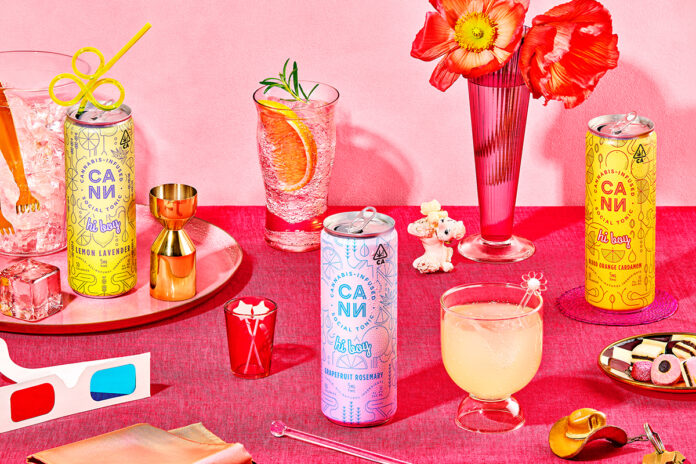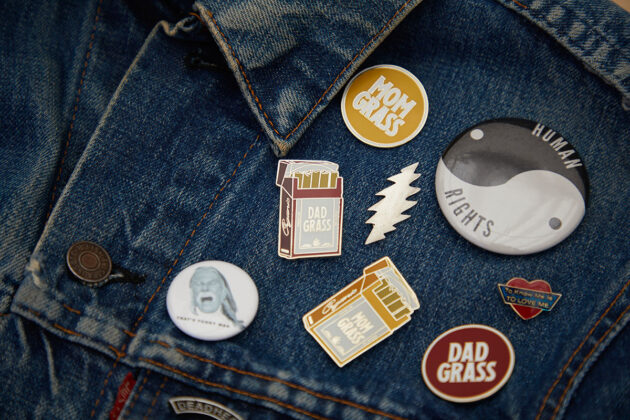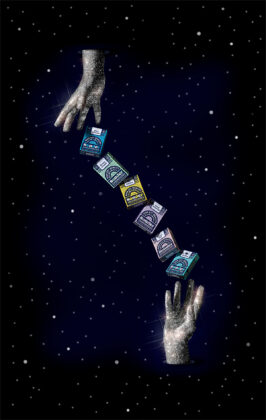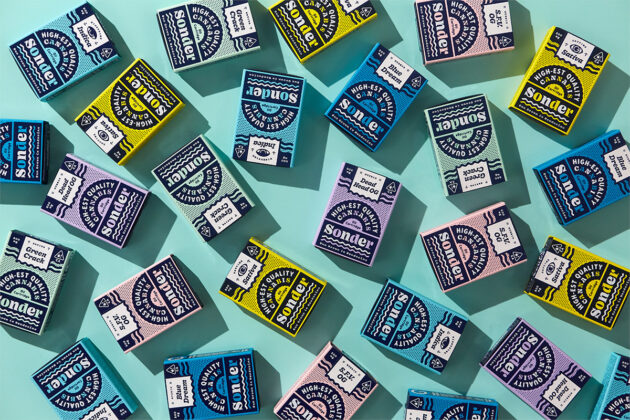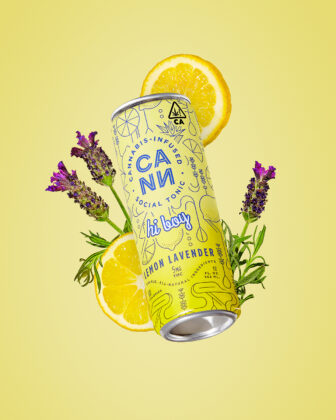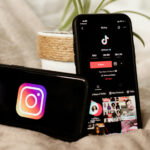We’ve said it many times on these pages: A brand is more than the sum of its collateral parts. Logo, packaging, marketing materials, advertising campaigns, product images… All those things create brand identity, which is only a fraction of cannabis branding—and a small fraction, at that.
The bigger part of branding is a difficult-to-define subconscious connection that helps a brand attract customers and transform them into fans. Product quality is essential, of course, but personality, authenticity, and an ability to convey heartfelt commitment arguably are the special sauce that holds everything together. The brand’s ethereal essence—its soul, if you will. Marc Gobé explained the concept more than twenty years ago in his book The New Paradigm for Connecting Brands to People. Since then, studies have shown emotion is a more powerful sales generator than traditional targeted advertising.
Kushy Punch, the California-based gummy powerhouse, was a branding grandmaster. Provocative, eccentric, and impressively imperfect, the company brimmed over and sloshed around with soul and charisma. From packaging so loud it hollered from the shelves to billboards boldly emblazoned with the image of a woman with her hair on fire, the brand embodied rebellion against the suits that tried to counter the counterculture.
Although its unorthodox reign among the kings of California cannabis came to an inglorious end at the hands of regulators, true fans remain devoted to the undeniably fun, brazen attitude in which Kushy Punch reveled. Legacy shops across the San Gabriel Valley still greet visitors with trodden Kushy Punch doormats, the saccharine lipstick logo grinning up at them. OG buyers get misty eyed when the company’s name comes up, lamenting its demise and the enormous emotional void the brand left behind.
I began my cannabis career in 2018 as the marketing director for Kushy Punch, tasked with putting the reins of creative discipline onto a charging bull and helping it defend its hefty share of the newly legal market. Led by brands like dosist, Canndescent, and Beboe, dispensary shelves were filling up with the first wave of sophisticated brands created by sophisticated people. Some of them were clearly defined, beautifully realized, and designed to calm the nerves of consumers tepidly entering dispensaries for the first time. Yet many others were bland, soulless efforts that did little to ignite the imagination. They were merely vessels to conquer a new commodity market, defined almost entirely by being the opposite of Kushy Punch and other legacy brands from the pre-recreational-use era.
But as cannabis has become increasingly normalized, the dull, safe brands feel much less relevant.
The meteoric rise of Cookies and its extremely creative and much-imitated mylar bags has been like a defibrillator to the soul of cannabis, and it may have been the brand’s efforts that first led me to ask: Where has all the personality in cannabis gone? Who are the soulful brands of today and what makes them so? Can the plant’s counterculture roots really exist in harmony with the constricting demands of market capitalism?
To help me tug this thread, I spoke to the creators of four brands to try to understand that special, unquantifiable something that helps them connect with their audiences on a deeper level and gives them soul.
Soul starts with a reason, a purpose
Creatives live for the unpredictable moments when the lightning bolt of inspiration hits them on the forehead, surging unlimited possibilities through them at a pace faster than the hand can capture. For entrepreneurs, that exhilarating state often stems from observing a gap no one is trying to fill or a perspective no one is voicing. Perhaps more incisively, it’s a raison d’être.
For Dad Grass, a 1970s-themed hemp smokes company based in Los Angeles, the reason is simply that weed is too damn strong these days. Company founders Joshua Katz and Ben Starmer found themselves longing for the bygone toke their parents used to smoke. They suspected they weren’t alone.
“The grass became too high,” said Starmer. “In the early ’70s, the average THC content in weed was 1 percent to 2.5 percent. Now you can’t find flower with less than 25 percent.”
Katz added, “Where was the microdose weed? You had microdose edibles, beverages, but no flower. Dogwalkers are just small joints that still get you really high, but that’s not the same.”
The pair arrived at a central question: Is cannabis an enhancement to an experience like a concert or a backyard barbecue, or is it an experience in itself? For them, the push for potency had made cannabis the latter.
Passing a whole Dad Grass hemp doobie around will get occasional users pleasantly baked. Being under the 0.3-percent THC limit, Dad Grass and its spousal brand Mom Grass (containing CBG flower) are available online and in hipster boutiques across the country, completely sidestepping the THC arms race that defines the flower category in dispensaries.
“It’s not a complex problem or a complex solution,” said Katz. “But sometimes the simplest solution just takes looking in the opposite direction.”
Spiked seltzer brand Cann was born of a similar central question: Could a low-dose cannabis beverage provide an alternative to low-dose alcohol like beer and wine? Cann founders Luke Anderson and Jake Bullock worked in the consumer packaged goods arm of the prestigious management consultancy Bain & Company. Weekend benders routinely provided some respite from their fast-paced, high-stakes careers, but as Anderson tells it, as he ticked over 30 his relationship with alcohol was “becoming untenable. I was living in the [United Kingdom], drinking far too much, and experiencing my first two-day-long hangovers,” he said.
At the same time, co-founder Bullock was completing a master’s degree at Stanford and had mocked up a prospective cannabis beverage concept, then called Heirloom. Anderson, who was feeling compelled to test his start-up bonafides, pushed for the two of them to explore the idea further.
At Bain, Anderson’s bread and butter was analyzing survey data about what consumers wanted. “I found about 60 percent of American consumers are interested in purchasing cannabis, but only 10 percent have actually done so in the past twelve months. And eight out of ten adults, when asked, say they want to drink less alcohol. The overlap there is massive.”
While observing such a market opportunity alone certainly doesn’t give a brand soul, it provides purpose. “Our goal became to make a product that looked and tasted like something that would get someone like me—curious about cannabis and looking to cut back on alcohol—to show up to a dispensary for the first time.”
Faun Chapin and her wife M, founders of Sonder, didn’t understand how a plant as magical as cannabis could be presented so drearily. “From a branding perspective, where in the world is the fun and curiosity in cannabis?” asked Chapin, who serves as the company’s chief executive officer. “Our culture has removed so much of that playfulness from adulthood, and we really wanted to make products that reignited that.”
Sonder’s Space Crystals, a line of 10mg pop rocks, is the flagship of the brand’s simple mission to make cannabis fun again. “There’s an entire experience associated with Space Crystals,” said Chapin. “You put them in your mouth, you feel them pop, there’s the sound. It’s such a delight to have all these sensations.”
But there was more method to the madness. “We wanted to tell the story of our moms, who were the OGs—the original growers—in the Emerald Triangle,” said Chapin, whose family has cultivated cannabis for more than fifty years. “The women were the gardeners of the family. They grew the weed next to their tomatoes and potatoes.
“When we first started Sonder, my family was still growing legally for the medical market,” she continued. “My mother taught my siblings everything about sustainable outdoor cannabis cultivation. There are actually twelve licensed cultivators out there that my mom taught.”
According to Chapin, the story of women as the pioneers of cannabis cultivation was a lost narrative. “We saw an opportunity to tell that story, build a family business, and put a different economic engine behind our creativity. We said, ‘Look, if we start a cannabis company and it’s successful, imagine the fun we’ll have.’”
Looking back with reverence is a common theme among brands with soul. Dad Grass, Sonder, and Old Pal all use nostalgia as an emotional device. When approached half-heartedly, nostalgia can be hammy and cheap. But when approached from a place of experience and with a flair for detail, brands take on a patina of permanence and timelessness.
“Old Pal looks to the past to make decisions about where we’re going in the future,” said co-founder and President Jason Osni. “Everything we do is kind of rooted in these old brands that have always existed. While Old Pal is new, what we’re offering in terms of sentiment and vibe isn’t. It’s old cannabis Americana.”
Osni has found that despite conjuring images of a bygone era, Old Pal’s culture has pan-generational appeal. “People are comfortable with that because it’s not such a deviation from what they were used to, and that’s why we appeal to Baby Boomers all the way down to Gen Z.”
Building loyalty and longevity
Both Old Pal and Dad Grass have done an exceptional job with ancillary products like T-shirts, tote bags, ashtrays, and dad hats. Doing merch well allows a brand to transcend its products and inspire and enable devotion, encouraging people to form a more intimate, lasting bond with the brand and what it says about their lifestyle.
Osni and co-founder Rusty Wilenkin have spotted their merch as far away as the Florida Keys and coffee shops in Paris. “I love walking into someone’s house and seeing the Old Pal Summerland ceramic apple pipe sitting on their bookshelf,” said Osni. “They’re looking up at Old Pal every single day. They’re the real fans right there.”
To bring Old Pal’s sepia-tinted world to life, Osni tapped high-profile Austin, Texas-based creative agency LAND. Known for its whimsical, text-heavy illustrative style, the agency took an ownership stake in Old Pal early on and has been the driving creative force behind the brand. “Right after Rusty and I, they were the third people involved in the business,” Osni said.
Osni is skeptical of having creatives geographically distant from the company’s homebase and felt LAND’s ownership interest encouraged the agency to completely buy into a long-term creative vision and refine the visual identity over time. The agency’s ongoing influence is most clearly visible in Old Pal’s elaborate Instagram page, which is a continuously evolving tapestry showcasing the prowess and aesthetic precision of a brand entirely clear about who it is. “The website, our socials, and the merch are all a tremendous amount of work and take a lot of creative bandwidth,” Osni said. “I think that’s the difference between a brand that survives and a brand that might be cool for a year and then disappears.”
Cann, too, sought creative counsel from an agency that would go on to develop an ownership stake. Red Antler, based in Brooklyn, New York, is one of the most influential design agencies working in consumer packaged goods, responsible for developing beloved Millennial brands like Casper, Allbirds, and Rent the Runway. The agency’s direct role was to put the finishing touches on the logo and brand guidelines; Cann brought the bulk of creative efforts in-house via its design unicorn Eliza Robson. Anderson credits the immense strength of engagement on the brand’s Instagram page to the collaboration between Cann’s in-house creatives and the founders.
“We write all the posts ourselves, and Eliza designs the images,” said Anderson, who touted the outsized role Robson plays in bringing Cann’s effervescent personality to life. “We have so much fun with it. It’s almost like a little insider’s meme page sometimes.”
Dad Grass’s Katz echoed Anderson’s advocacy for making creativity an internal engine if possible. He also sees the limitations of relying on an agency to maintain the brand beyond its creation. “Agencies build brands, not businesses,” he said. “You can outsource packaging, copywriting, photography, but if everything is going to connect together and be responsive to the business, you have to have the in-house intellectual capital.”
Dad Grass’s co-founders share creative direction duties, with Katz the source of the brand’s impeccable dad-joke-heavy copy and Starmer as the still-life photographer. Together they have a firm hand on consumer-facing creative and have managed the brand’s tone with remarkable consistency as it has grown and matured.
Curiously, Sonder’s founders own a creative collective, Guts & Glory, which has a storied history in New York advertising and editorial. They, too, admit “you have a different type of outcome when creativity is built into the business,” citing the creative harmony and efficiency of output that comes with building an internal operation. “You’re able to approach problems in different ways and do so faster, more efficiently, and more organically because you don’t have barriers between the different groups,” said Chapin.
When it comes to building creative teams, diversity of opinion and perspective is crucial to speaking to a diverse audience. Sonder and Cann are both queer-owned and -operated. Chapin and M have been married for a decade. Of the six people in leadership positions at Cann, “none of them are straight white males,” said Anderson, which he rightly observed is a rarity in the cannabis industry. “California is one of the most diverse states in the nation. To be able to speak authentically to a broad audience like that you have to have a multitude of different perspectives,” he said.
Cann became the darling of Pride this year. Its blockbuster out-of-home advertising campaign riffed on the Fantanas (the faces of Fanta in the 1990s) but included drag artists Symone and Gigi Goode of Ru Paul’s Drag Race. The campaign cemented Cann as a fun brand synonymous with supporting creativity and inclusion within the LGBTQ community. “We approached Pride with intention, elevating queer artists at every touchpoint of the creative process,” Anderson said.
Mythical or mystical?
Taking a step back, do all these checkpoints—purpose and narrative, creative founders, diversity of opinion, advocacy—come together to magically create soul within a brand? If a fledgling brand were to carefully consider such dimensions before entering the market, would it stand a few feet taller? Probably, but that alone wouldn’t necessarily make the brand “soulful.”
Soul, it seems, cannot be commissioned, bought, or added like an ingredient. It’s really about the humans behind the brand and how tangible their personalities are. If the entrepreneurs who first observed the opportunity, built the brand, and agonized over its guidelines continue to be actively involved in the presentation and execution, the brand takes on a human quality and transcends the confines of its packaging and application. You can feel its spirit in the copy, the photography, the merch, the in-store presence and, most importantly, how consumers connect and identify with the brand.
The founding concepts for all the brands featured in this piece—low-dose jays; playful products; affordable, consistent weed; alternative to alcohol—are simple and repeatable. But the personalities beneath the brands are the unseen, unrepeatable mystique that makes them stand out from the imitators all of them have spurred.
Katz and Starmer are still very much in the creative weeds at Dad Grass, and in all likelihood will remain there as the brand grows, building a team around the imperative they stay at the creative helm. Chapin and M are Sonder. They are intrinsically woven into the brand narrative, and you can feel their tender creative handiwork at every touchpoint. Osni of Old Pal thinks about brand positioning “constantly. That doesn’t mean I’m sitting here drawing new logos all day,” he said, “but I’m always asking ‘are we being true to what we set out to do?’” Despite the intensity of their national trajectory, Anderson and Bullock continue to be actively involved in the presentation of Cann, though maintaining that closeness will be a defining challenge for them.
That leads to the inevitable, if bizarre, question: Is soul scalable?
Old Pal’s and Cann’s major multistate success suggest it can be, but reaching the goal takes prioritizing creativity and keeping the founders in customer-facing roles by building a team to preserve the connection. Introducing big money and the big expectations that come with it doesn’t necessarily mean the soul of a brand will wither, but typically the move pulls the founders away from the front lines and delegates soul maintenance to someone who didn’t create and nurture the brand. Perhaps some of the major brands or multistate operator private labels appear soulless because there is no indication a human being actually created them. They easily could have been the product of an artificially intelligent algorithm fed Pinterest boards and commanded to spit out product catalogs.
For Katz—who has been a brand consultant to Reebok, Ben Sherman, Puma, and Levi’s, arguably the most enduring emblems of American cool—this is a problem across all consumer goods categories and has led to a prevailing sense that everything looks the same, at least on the surface. “A lot of Millennial-focused brands are venture-backed and designed to get to market as quickly as possible and grow as fast as possible,” he said. “Usually, they’re not brands or businesses the founders have a fundamental passion for or a personal connection to. I think that’s one of the things customers can detect pretty keenly.”
Perhaps, then, in branding there is no force greater than the passion and zeal of a creative entrepreneur on a mission. When that consistently is channeled into audience-facing creative, it can transform something mundane into something special, intimate and, yes, soulful. Creative entrepreneurs face challenges preserving this closeness as they scale, so it’s important they prioritize the brand’s foundational core and build around it. Because if the soul strays too far from the source, products become just more faceless, bland boxes languishing on store shelves.







